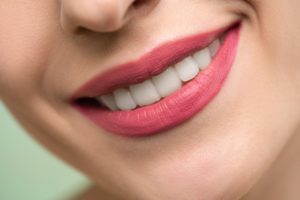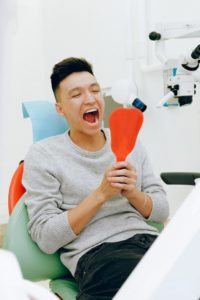 Tooth discolouration can be categorically divided into intrinsic, extrinsic, or a combination of both.
Tooth discolouration can be categorically divided into intrinsic, extrinsic, or a combination of both.
Intrinsic discoloration occurs inside the tooth itself when chromatogenic content (substance that produces colour) is incorporated into the dentin and enamel layer of the teeth during tooth developmentprocess or after eruption of teeth into the mouth. Tooth discoloration before eruption can be caused by increased fluoride intake, tetracycline (a type of antibiotics) intake, hereditary developmental conditions, and trauma to the developing tooth. Ageing and pulp necrosis are other main causes of intrinsic tooth discoloration.
Extrinsic stain on the teeth is caused by coffee, tea, red wine, carrots, oranges, and tobacco consumption. Wearing off of the tooth structure causes changes in the dentine layer of the teeth. This change in structure is called the secondary dentine. Deposition of secondary dentin as a result of ageing or pulp necrosis (tooth dying), inflammation, and dentin sclerosis affect the light-transmitting properties of teeth, resulting in a progressive darkening of the teeth. Scaling and polishing of the teeth may remove someextrinsic stains. For more stubborn extrinsic discoloration and intrinsic stain, various bleaching techniques may be attempted.
Tooth bleaching can be done externally (night guard vital bleaching or vital tooth bleaching) or intracoronally (non-vital tooth bleaching) in root-filled teeth. Intracoronal bleaching is done within the crown of a tooth previously treated with root canal treatment.
 Bleaching of discoloured, pulpless teeth was first introduced in 1864. A variety of medicaments, including chloride, sodium hypochlorite, sodium perborate, and hydrogen peroxide have been used individually, in combination, and with orwithout heat activation. The “walking bleach” procedure, first used in 1961, involved injecting a solution of sodium perborate and water into the pulp chamber, which was then sealed off between visits to the dentist. To boost the whitening effect, the process was later changed and water was substituted with 30-35 percent hydrogen peroxide. An orthodontist who had recommended an antiseptic containing 10% carbamide peroxide to be used in a tray for the treatment of gingivitis made the discovery that carbamide peroxide induced tooth lightening in the late 1960s. The discovery was shared with other colleagues, and it is widely considered to be the start of the night guard bleaching period. The process explaining the use of 10% carbamide peroxide in a mouth guard to be worn overnight for lightening tooth colour was published more than 20 years later.
Bleaching of discoloured, pulpless teeth was first introduced in 1864. A variety of medicaments, including chloride, sodium hypochlorite, sodium perborate, and hydrogen peroxide have been used individually, in combination, and with orwithout heat activation. The “walking bleach” procedure, first used in 1961, involved injecting a solution of sodium perborate and water into the pulp chamber, which was then sealed off between visits to the dentist. To boost the whitening effect, the process was later changed and water was substituted with 30-35 percent hydrogen peroxide. An orthodontist who had recommended an antiseptic containing 10% carbamide peroxide to be used in a tray for the treatment of gingivitis made the discovery that carbamide peroxide induced tooth lightening in the late 1960s. The discovery was shared with other colleagues, and it is widely considered to be the start of the night guard bleaching period. The process explaining the use of 10% carbamide peroxide in a mouth guard to be worn overnight for lightening tooth colour was published more than 20 years later.
In-office or power bleaching, at-home or dentist-supervised night-guard bleaching and bleaching with over the counter (OTC) items are the three main methods for bleaching vital teeth.
On the other hand, walking bleach and modified walking bleach, non-vital power bleaching, and inside/outside bleaching are only a few of the non-vital bleaching methods used today. The walking bleach method entails sealing a solution of sodium perborate and water into the pulp chamber of the affected tooth, then repeating the process until the desired bleaching result is obtained. This technique is modified with a combination of 30% hydrogen peroxide and sodium perborate sealed into the pulp chamber for one week; this is known as modified walking bleach.
How long does the effect of teeth bleaching last?
Because there is such a wide range of whitening options, the average teeth bleaching resultcan last anywhere from six months to three years. In most cases, however, people tend to have results that last for about one year.
Is laser teeth whitening better than bleaching?
The laser involved in this procedure heats up the oxygen process quickly, which is the part that breaks down layers of stains in your tooth enamel. It is a quicker process than whitening trays because in just a few short sessions, a patient will visibly see whiter results faster than any other method. However, the end results of all techniques are similar
Dr Aws Hashim Ali Al-Kadhim, Dr Muhammad Syafiq Alauddin and Dr Azlan Jaafar are researchers and clinical lecturers at Faculty of Dentistry, Univeristi Sains Islam Malaysia.
[This article belongs to The Malaysian Medical Gazette. Any republication (online or offline) without written permission from The Malaysian Medical Gazette is prohibited.]
